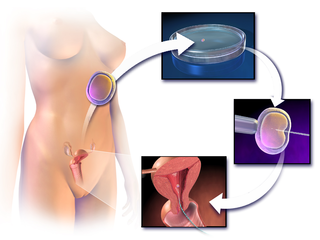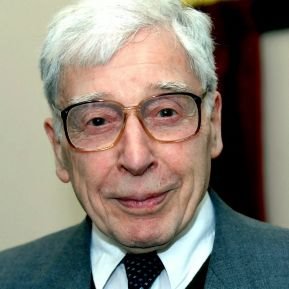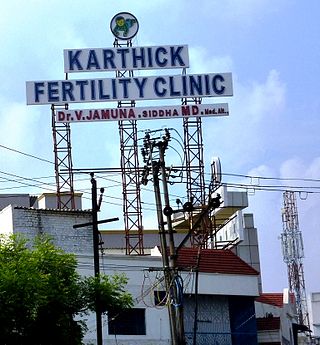
In vitro fertilisation (IVF) is a process of fertilisation where an egg is combined with sperm in vitro. The process involves monitoring and stimulating a female's ovulatory process, removing an ovum or ova from their ovaries and letting sperm fertilise them in a culture medium in a laboratory. After the fertilised egg (zygote) undergoes embryo culture for 2–6 days, it is transferred by catheter into the uterus, with the intention of establishing a successful pregnancy.
Louise Joy Brown is an English woman who was the first human to have been born after conception by in vitro fertilisation experiment (IVF). Her birth, following a procedure pioneered in Britain, has been lauded among "the most remarkable medical breakthroughs of the 20th Century".

Patrick Christopher Steptoe CBE FRS was an English obstetrician and gynaecologist and a pioneer of fertility treatment. Steptoe was responsible with biologist and physiologist Robert Edwards and the nurse Jean Purdy for developing in vitro fertilisation. Louise Joy Brown, the first test-tube baby, was born on 25 July 1978. Edwards was awarded the 2010 Nobel Prize in Physiology or Medicine for his work on the development of in vitro fertilisation; Steptoe and Purdy were not eligible for consideration because the Nobel Prize is not awarded posthumously.

Assisted reproductive technology (ART) includes medical procedures used primarily to address infertility. This subject involves procedures such as in vitro fertilization (IVF), intracytoplasmic sperm injection (ICSI), cryopreservation of gametes or embryos, and/or the use of fertility medication. When used to address infertility, ART may also be referred to as fertility treatment. ART mainly belongs to the field of reproductive endocrinology and infertility. Some forms of ART may be used with regard to fertile couples for genetic purpose. ART may also be used in surrogacy arrangements, although not all surrogacy arrangements involve ART. The existence of sterility will not always require ART to be the first option to consider, as there are occasions when its cause is a mild disorder that can be solved with more conventional treatments or with behaviors based on promoting health and reproductive habits.

Surrogacy is an arrangement, often supported by a legal agreement, whereby a woman agrees to delivery/labour on behalf of another couple or person, who will become the child's parent(s) after birth. People may seek a surrogacy arrangement when a couple do not wish to carry a pregnancy themselves, when pregnancy is medically impossible, when pregnancy risks are dangerous for the intended mother, or when a single man or a male couple wish to have a child.

Sir Robert Geoffrey Edwards was a British physiologist and pioneer in reproductive medicine, and in-vitro fertilisation (IVF) in particular. Along with obstetrician and gynaecologist Patrick Steptoe and nurse Jean Purdy, Edwards successfully pioneered conception through IVF, which led to the birth of Louise Brown on 25 July 1978. They founded the first IVF programme for infertile patients and trained other scientists in their techniques. Edwards was the founding editor-in-chief of Human Reproduction in 1986. In 2010, he was awarded the Nobel Prize in Physiology or Medicine "for the development of in vitro fertilization".
Thomson Medical Centre Limited is a 190-bed private hospital located at Thomson Road in Singapore. The hospital specialises in gynaecology and in vitro fertilisation (IVF). Thomson Medical Centre runs a 24-hour outpatient family clinic, as well as a range of specialist clinics.

Fertility clinics are medical clinics that assist couples, and sometimes individuals, who want to become parents but for medical reasons have been unable to achieve this goal via the natural course. Clinics apply a number of diagnosis tests and sometimes very advanced medical treatments to achieve conceptions and pregnancies.
Sammy Lee was an expert on fertility and in vitro fertilisation

Peter Robert Brinsden MBBS, MRCS, LRCP, FRCOG is known for the treatment of infertility in couples. From 1989 to 2006 he was the medical director of Bourn Hall Clinic in the UK, a leading centre for the treatment of fertility problems, and where about 6,000 babies have been conceived using IVF and other assisted conception treatments.

The Human Fertilisation and Embryology Act 1990 is an Act of the Parliament of the United Kingdom. It created the Human Fertilisation and Embryology Authority which is in charge of human embryo research, along with monitoring and licensing fertility clinics in the United Kingdom.
Fertility tourism is the practice of traveling to another country or jurisdiction for fertility treatment, and may be regarded as a form of medical tourism. One can usually be considered as having fertility issues when they are unable to have a clinical pregnancy after 12 months of attempts with intercourse. Infertility, or the inability to get pregnant, affects about 8-12% of couples looking to conceive or 186 million people globally. In some places, rates of infertility surpass the global average and can go up to 30% depending on the country. Areas with lack of resources, such as assisted reproductive technologies (ARTs), tend to correlate with the highest rates of infertility.

John Webster FRCOG is an English obstetrician and gynaecologist. Present at the world's first in vitro fertilisation (IVF) birth, Louise Brown, Webster has continued to develop and further research in the field of IVF.
Sudarshan Ghosh Dastidar is an Indian doctor and a former Indian politician and the Minister for Environmental Affairs in the Government of West Bengal. He is also an MLA, elected from the Mahisadal constituency in the 2011 West Bengal state assembly election.
Jacques Cohen is a Dutch embryologist based in New York, U.S. He is currently Director at Reprogenetics LLC, Laboratory Director at ART Institute of Washington at Walter Reed National Military Medical Center, and Scientific Director of R & D at IVF-online.
The history of in vitro fertilisation (IVF) goes back more than half a century. In 1959 the first birth in a nonhuman mammal resulting from IVF occurred, and in 1978 the world's first baby conceived by IVF was born. As medicine advanced, IVF was transformed from natural research to a stimulated clinical treatment. There have been many refinements in the IVF process, and today millions of births have occurred with the help of IVF all over the world.
Simon Fishel is an English physiologist, biochemist and pioneering in vitro fertilisation (IVF) specialist.

Jean Marian Purdy was a British nurse and embryologist and a pioneer of fertility treatment. Purdy was responsible with Robert Edwards and Patrick Steptoe for developing in vitro fertilisation. Louise Joy Brown, the first test-tube baby, was born on 25 July 1978, and Purdy was the first to see the embryonic cells dividing. Edwards was awarded the 2010 Nobel Prize in Physiology or Medicine for his work on the development of in vitro fertilisation; however, because the Nobel Prize is not awarded posthumously, neither Purdy nor Steptoe were eligible for consideration. Purdy was a co-founder of the Bourn Hall Clinic but her role there and in the development of IVF was ignored for 30 years.
Bavishi Fertility Institute is an India based centre for the treatment of infertility and care. The hospital specialises in vitro fertilisation (IVF) and surrogacy. The institute is located in five cities Ahmedabad, Surat, Mumbai, Delhi and Kolkata.
Louisa Maria Ghevaert is a solicitor of the Senior Courts of England and Wales.











